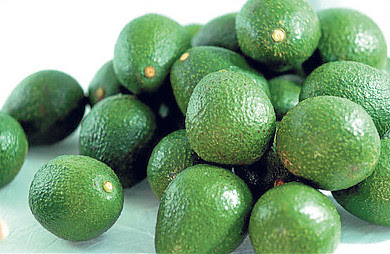With a name derived from a Mexican word meaning ‘testicle’ and branded ‘alligator pear’ due to the scaly appearance of its skin, the avocado is hardly blessed with good looks.
But what it lacks in appearance, this super fruit more than makes up for in flavour and health benefits, having been found to help lower cholesterol.
High in mono-unsaturated fat, omega-3 and Vitamin E, avocados are also rich in fibre and contain 60% more potassium than bananas.
Known as the fertility fruit by the Aztecs, the avocado has become an integral part of the Mediterranean diet since its introduction to Europe in the 1500s.
Native to central Mexico and classified in the flowering plant family Lauraceae, avocados are commercially valuable and are now cultivated in Tropical and Mediterranean climates throughout the world.
The warm lowland's climate in Andalusia has led to it becoming a key area for the cultivation of avocados in Europe, with up to 60,000kg produced each year in the Axarquia alone.
While avocados are available in Spain 365 days of the year, now is the perfect time to make the most of the fruit while it is at its best. The avocado season runs from October to May.
In the shops, look for varieties with a ‘give’ to the flesh and do not refrigerate as they will not ripen properly. Over-ripeness will result in discoloured or mushy flesh.
Here in the garden at Cortijo Azahar we are blessed with a mature avocado tree and can pick our own buttery, fragrant fruit over the winter.
Just get hooked on avocado!
Peel it, cut it up and drizzle a little balsamic, bit of fresh cracked pepper, so amazing on its own.
Try to have one at least 2-3 times each week!
It may sound a little hard to believe, but Avocados are a wonderful aid in helping to recover from a hangover. Hope you don't have to use them for that particular reason, but should the occasion arise, try them. You'll see!
Avocado and Prawn Cups
Here, lettuce-lined bowls are filled with prawns and
avocado, mixed with spiced new potatoes and topped with yogurt for a
real hot and cold taste explosion.
Serve avocado and prawn cups for
lunch with whole-wheat or multi-grain bread.
600 g new potatoes, washed and diced
2 tablespoons olive oil
1 small red onion, thinly sliced
1 garlic clove, crushed
1 large mild red chili, seeded and finely chopped
1 teaspoon coriander seeds, roughly crushed
1 teaspoon cumin seeds, roughly crushed
1 large avocado
400 g peeled cooked prawns
juice of 2 limes
pepper to taste
8 tablespoons plain low-fat yogurt
4 tablespoons chopped fresh coriander
8 round lettuce leaves
2 tablespoons olive oil
1 small red onion, thinly sliced
1 garlic clove, crushed
1 large mild red chili, seeded and finely chopped
1 teaspoon coriander seeds, roughly crushed
1 teaspoon cumin seeds, roughly crushed
1 large avocado
400 g peeled cooked prawns
juice of 2 limes
pepper to taste
8 tablespoons plain low-fat yogurt
4 tablespoons chopped fresh coriander
8 round lettuce leaves
- Cook the potatoes in a saucepan of boiling water for 8 minutes or until just tender. Drain and rinse under cold running water. Dry in a clean dish towel.
- Heat the oil in a frying pan, add the onion and fry for 5 minutes or until softened and lightly browned. Add the garlic, chili and crushed coriander and cumin seeds, and cook for 1 more minute, stirring. Stir in the potatoes and fry over a high heat for 3 minutes. Remove from the heat and leave to cool.
- Peel the avocado, remove the pit and cut the flesh into small chunks. Add to the potatoes together with the prawns and lime juice. Season with pepper and toss gently.
- Mix together the yogurt and coriander and season with pepper. Arrange 2 lettuce leaves in each of 4 bowls. Spoon the avocado and prawn salad into the cups and top with the coriander yogurt.
Chilled Andalusia Avocado Soup (Sopa de Aguacate)
Ingredients
3 ripe
avocados in excellent condition
1 plump garlic clove, pressed through a garlic press
Juice of 1 lime
2 cups chicken stock
½ teaspoon cumin
¼ cup sour cream or crème fraiche
1 cup ice-cold water
Freshly ground salt and pepper
Garnish: chopped fresh parsley or cilantro & minced red onion
1 plump garlic clove, pressed through a garlic press
Juice of 1 lime
2 cups chicken stock
½ teaspoon cumin
¼ cup sour cream or crème fraiche
1 cup ice-cold water
Freshly ground salt and pepper
Garnish: chopped fresh parsley or cilantro & minced red onion
Preparation
- Peel and remove the pits from the avocados. Coarsely chop the flesh and place in a blender. Add the crushed garlic, lime juice and chicken stock; puree until smooth.
- Add the cumin, sour cream or crème fraiche, cold water and season generously with freshly ground salt and pepper to taste.
- Chill for 2-3 hours before serving. Serve in chilled glasses with a garnish of fresh parsley or cilantro, minced red onion and a drizzle of fruity olive oil.
Serves:
6 appetizer portions






